As AI assistants evolve, GPT-5 and Claude Sonnet 4.5 stand out as the most capable large language models yet. Dive in and see how they stack up.
Keep reading
2025 has been a defining year for AI. OpenAI’s GPT-5 and Anthropic’s Claude Sonnet 4.5 have raised the bar once again, each one aiming to blend stronger reasoning, longer memory, and more autonomy into one seamless system. Both are built to handle coding, research, writing, and enterprise-scale tasks, yet their design philosophies differ sharply.
This breakdown explores how the two stack up across performance, reasoning, coding, math, efficiency, and cost, helping users and teams decide where each model truly shines.
A Quick Overview
Claude Sonnet 4.5 builds on Anthropic’s refined Claude family. It extends memory across sessions, handles million-token contexts via Amazon Bedrock and Vertex AI, and features smart context management that prevents sudden cut-offs. It can run autonomously for 30 hours on extended tasks, making it ideal for ongoing workflows.
Meanwhile, GPT-5 is OpenAI’s flagship successor to GPT-4, tuned for agentic reasoning, where the model plans, executes, and coordinates tools on its own. Its adaptive reasoning system dynamically chooses between shallow or deep “thinking” paths, letting users balance speed, cost, and depth per task. GPT-5 also offers specialized variants (Mini, Nano) for lighter workloads.
Reasoning and Analysis
Both models far exceed their 2024 counterparts, but they differ in how they reason.
GPT-5’s deep-reasoning mode significantly boosts performance in multi-step logic, scientific, and spatial tasks. It can break problems into chains, test sub-hypotheses, and self-correct mid-process. However, disabling this mode reduces accuracy sharply, it can be brilliant when “thinking deeply,” but more variable when not.
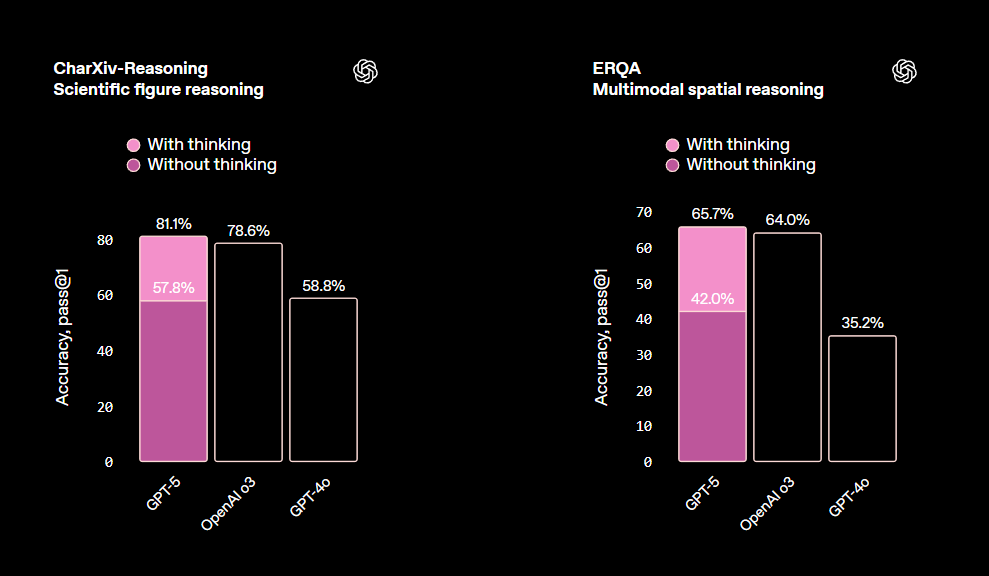
Claude Sonnet 4.5, by contrast, stays stable even without added configuration. It’s particularly strong in financial, policy, and business logic, where structure and coherence matter more than creative leaps. For enterprise Q&A or decision support, that predictability is valuable.

If you want an AI that reasons steadily, Claude takes the lead. If you need exploratory logic (i.e. complex hypothesis testing or cross-domain synthesis) GPT-5’s deeper path is unmatched.
Math and Structured Problem Solving
As seen in the benchmarks provided by Anthropic, Claude Sonnet 4.5 continues its consistency streak. Whether calculating directly or using Python tools, it achieves top-tier math accuracy. This means it handles structured logic even in constrained environments.
GPT-5 also reaches near-perfect accuracy, but only when tool use and reasoning depth are active. Disable them, and results drop noticeably. It relies heavily on its reasoning pipeline to stay sharp.
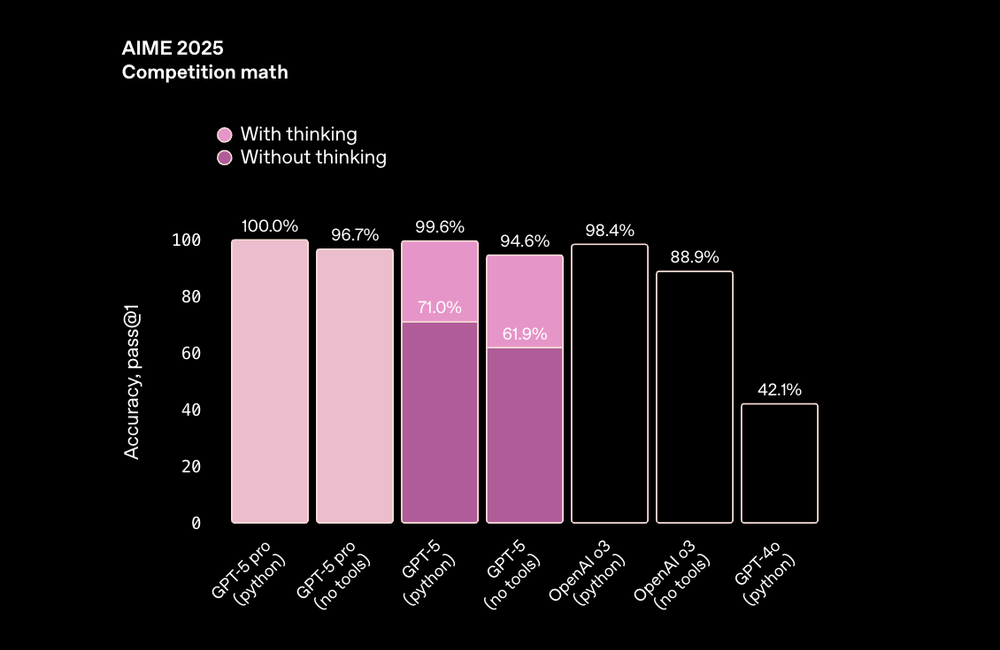
Verdict:
- Claude Sonnet 4.5: dependable out-of-the-box math solver.
- GPT-5: flexible but needs tuning to perform at its best.
Coding and Software Engineering
When it comes to coding, the two models diverge in style.
Claude Sonnet 4.5 delivers stable performance without special tuning. In tests resembling HumanEval+ and MBPP+, it maintains high accuracy across conditions, making it dependable for production pipelines. Its strength lies in consistency, results rarely fluctuate, which is crucial for enterprise use.

By contrast, GPT-5 achieves higher peak scores when its advanced reasoning is enabled, especially in multi-language or large-project contexts. In JavaScript and Python refactoring tasks, for instance, it outperformed Sonnet when its “high-reasoning” mode was active — though baseline runs without that mode varied more.
For agentic coding, where the AI calls external tools or terminals, Sonnet 4.5 often executes with fewer dropped commands. GPT-5, on the other hand, can chain more tool calls simultaneously, making it better for complex orchestration, provided you configure it carefully.
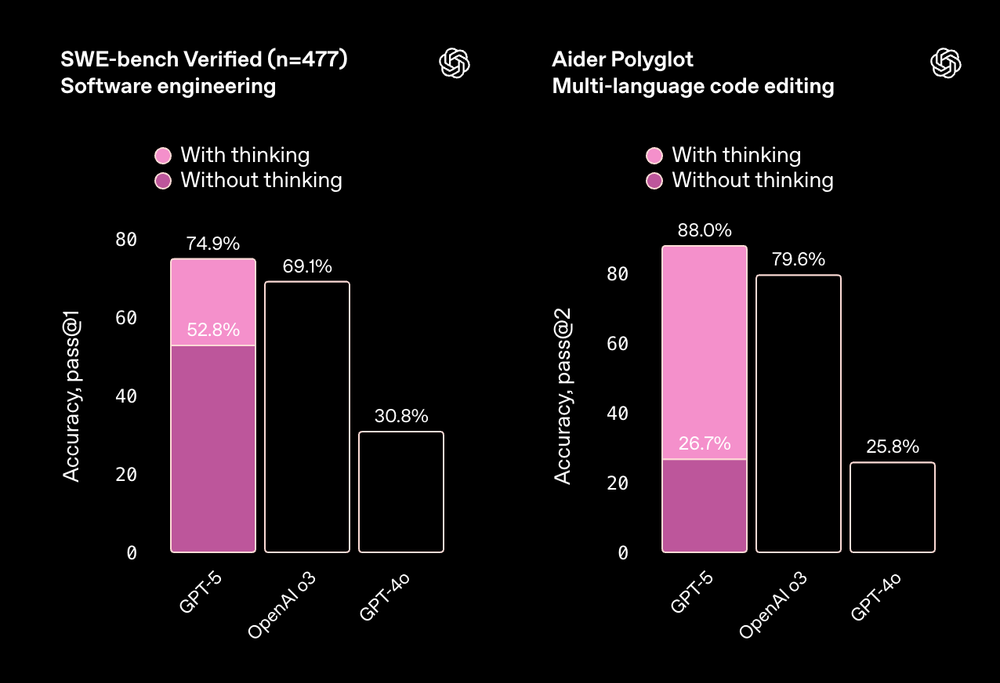
Verdict:
- Claude Sonnet 4.5: predictable, steady engineering partner.
- GPT-5: versatile powerhouse, but performance hinges on setup.
Cost and Efficiency
GPT-5 is clearly cheaper per token, particularly for large inputs. Its adaptive router also saves compute by running simple prompts on lighter paths.
Claude Sonnet 4.5 charges more but maintains predictable latency, a key factor for production environments that value reliability over marginal savings. For very large prompts, its cost rises faster than GPT-5’s, though batch discounts narrow the gap.
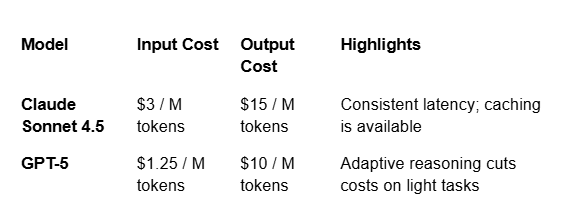
TL;DR: GPT-5 wins on price and scalability, whereas Claude wins on timing consistency and stability.
Pricing for Premium Plans
Beyond API access, both OpenAI and Anthropic offer premium subscriptions for individual users, which differ in features and pricing.
ChatGPT Plus, powered by GPT-5, is priced at $20 per month, giving users priority access to GPT-5, faster response times, and early access to new features and memory. OpenAI’s unified ChatGPT experience also includes file uploads, image generation, and custom GPTs.
Claude Pro, meanwhile, costs $20 per month as well and grants access to Claude Sonnet 4.5, offering faster responses, higher rate limits, and longer context windows. While it lacks built-in multimodal tools, Claude focuses on text clarity and structured reasoning, appealing to researchers, analysts, and writers seeking dependability over versatility.
TL;DR: both Plus plans are tied in price; what sets them apart, however, is their offering.
Different Strengths for Different Needs
It’s tempting to crown one “best,” but GPT-5 and Claude Sonnet 4.5 serve different priorities for different users and teams.
- Claude Sonnet 4.5: best for reliability and sustained performance. If you want consistent outputs and clear memory behavior, Claude delivers.
- GPT-5: best for depth, flexibility, and scalability. When configured properly, it surpasses rivals in creative reasoning, multimodal integration, and adaptive tool use.
Most teams may find the strongest setup is multi-model, using Claude where consistency matters most, and GPT-5 for data-intensive workflows.
Ultimately, these aren’t just chatbots anymore, they’re full-fledged digital collaborators, each with distinct personalities. Claude Sonnet 4.5 is your calm, methodical analyst. GPT-5 is your ambitious polymath. Which one you pick depends less on their individual benchmarks and more on your mission.
NEWS AND UPDATES
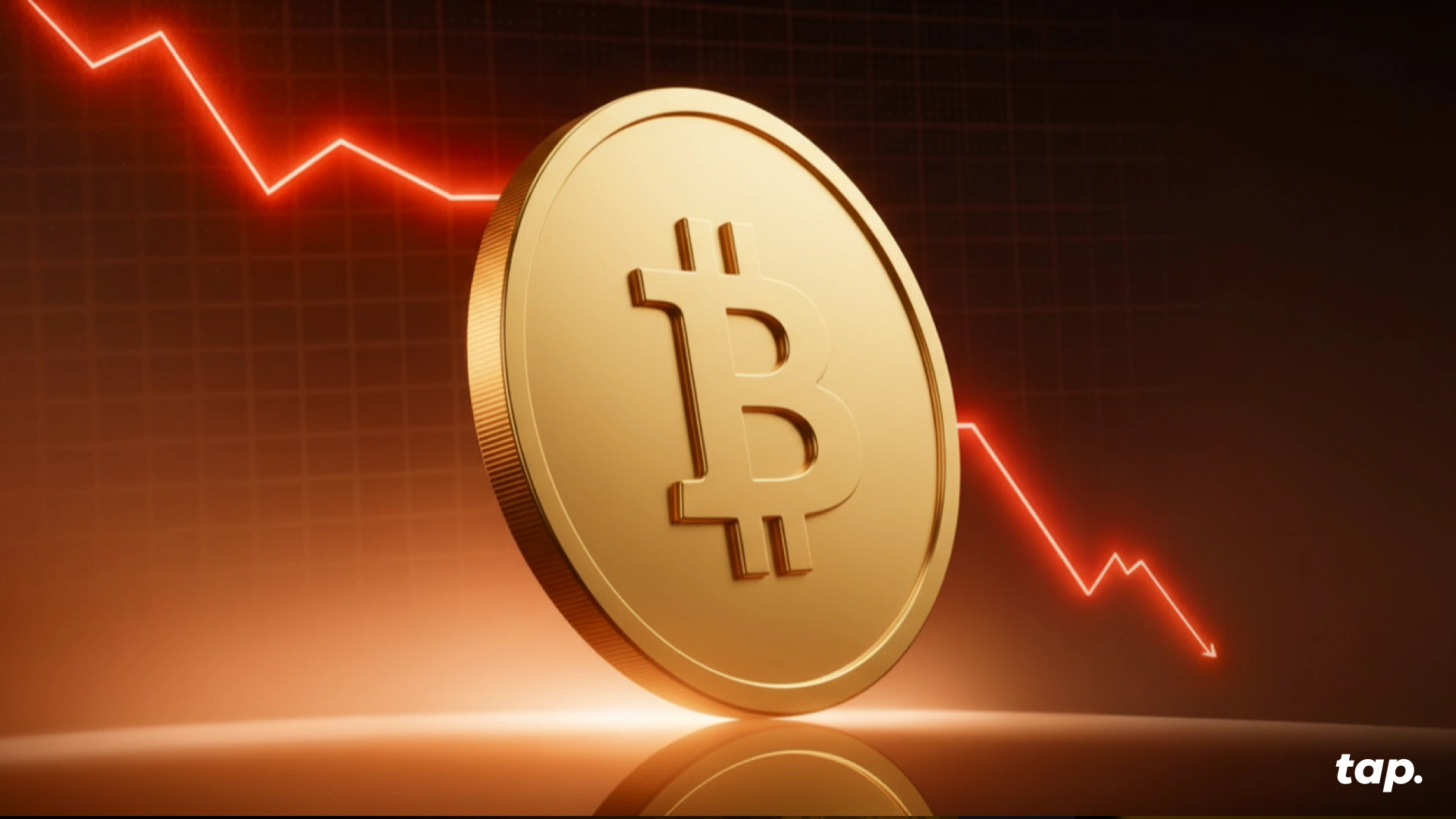
After a brutal October sell-off, crypto just staged one of its most dramatic comebacks yet. Here's what the market's resilience signals for what comes next.
The crypto market just pulled off one of its boldest recoveries in recent memory. What began as a violent sell-off on October 10 has given way to a surprisingly strong rebound. In this piece, we’ll dig into “The Great Recovery” of the crypto market, how Bitcoin’s resilience particularly stands out in this comeback, and what to expect next…
The Crash That Shook It All
On October 10, markets were rattled across the board. Bitcoin fell from around $122,000 down to near $109,000 in a matter of hours. Ethereum dropped into the $3,600 to $3,700 range. The sudden collapse triggered massive liquidations, nearly $19 billion across assets, with $16.7B in long positions wiped out.
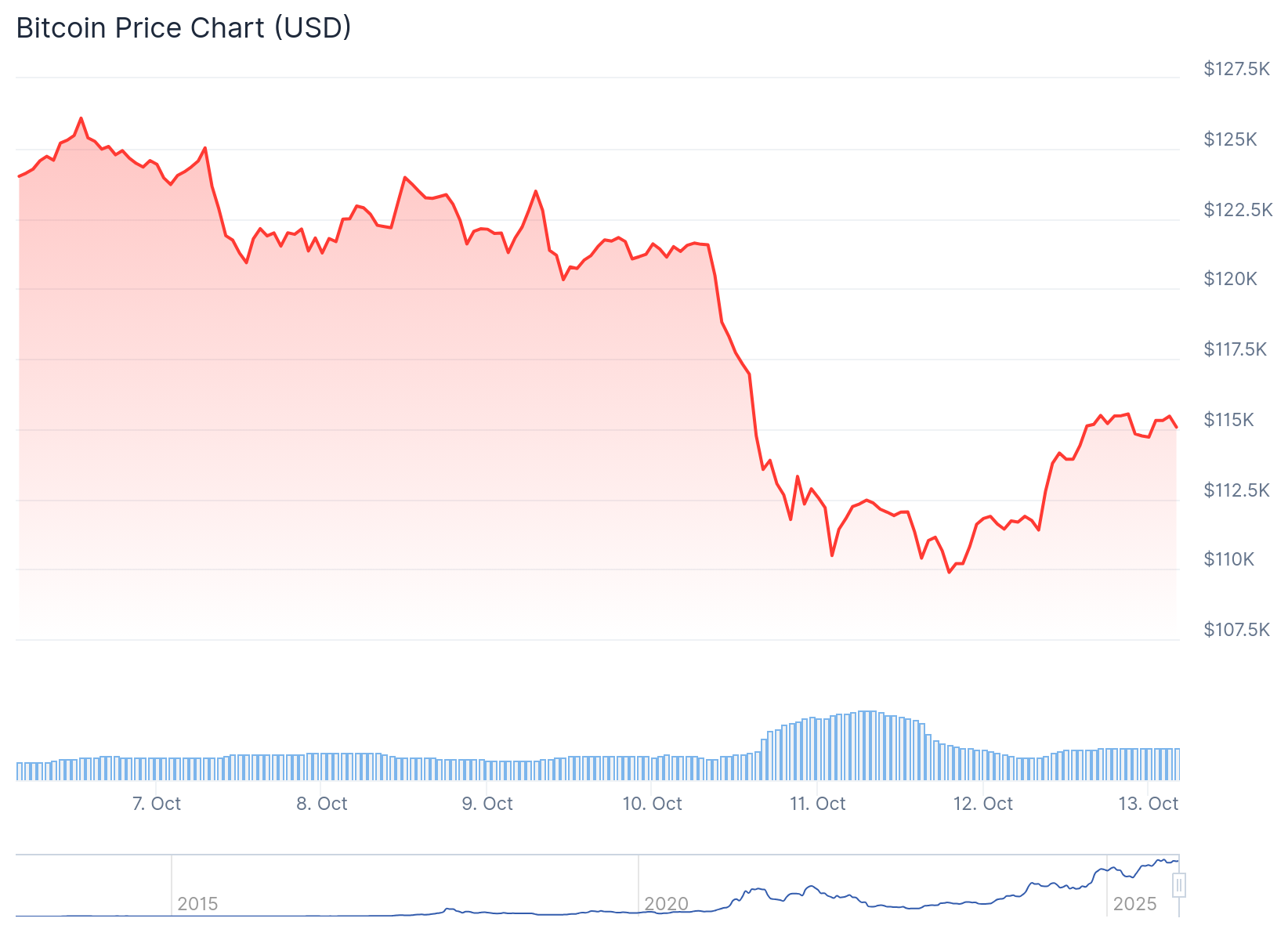
That kind of forced selling, often magnified by leverage and thin liquidity, created a sharp vacuum. Some call it a “flash crash”; an overreaction to geopolitical news, margin stress, and cascading liquidations.
What’s remarkable, however, is how quickly the market recovered.
The Great Recovery: Scope and Speed
Within days, many major cryptocurrencies recouped large parts of their losses. Bitcoin climbed back above $115,000, and Ethereum surged more than 8%, reclaiming the $4,100 level and beyond. Altcoins like Cardano and Dogecoin led some of the strongest rebounds.
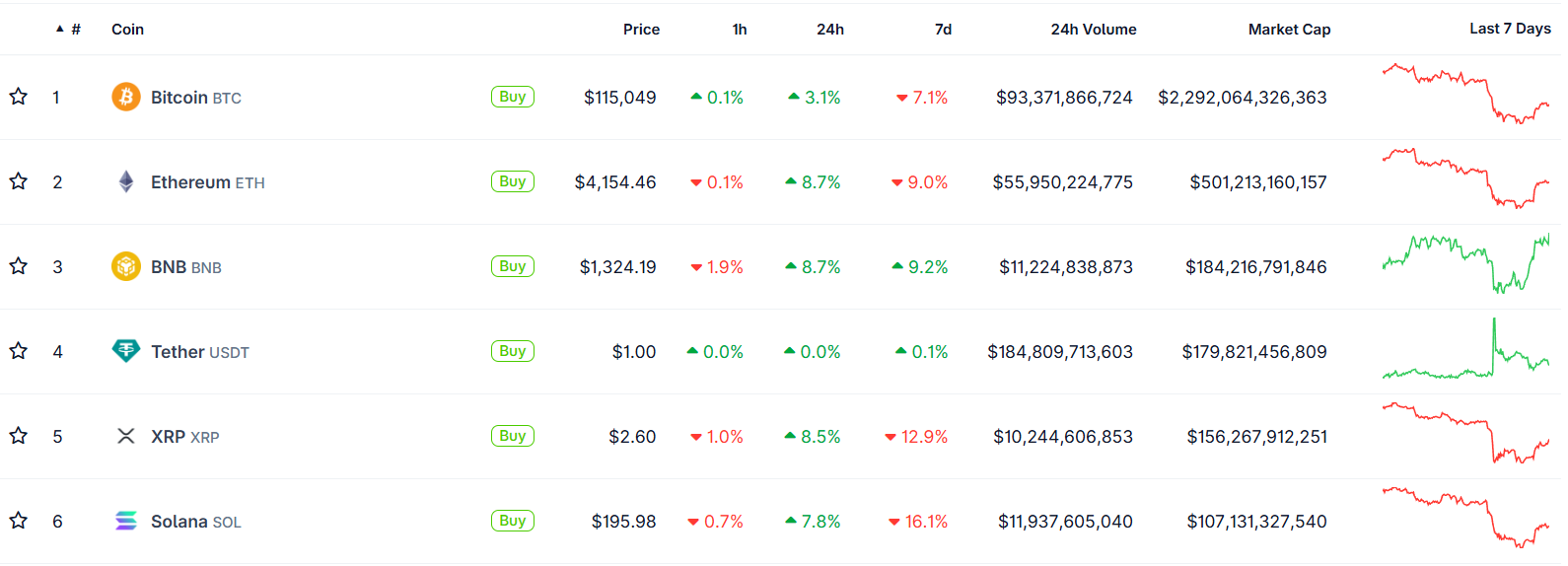
One narrative gaining traction is that this crash was not a structural breakdown but a “relief rally”, a market reset after overleveraged participants were squeezed out of positions. Analysts highlight that sell pressure has eased, sentiment is stabilizing, and capital is re-entering the market, all signs that the broader uptrend may still be intact.
“What we just saw was a massive emotional reset,” Head of Partnerships at Arctic Digital Justin d’Anethan said.
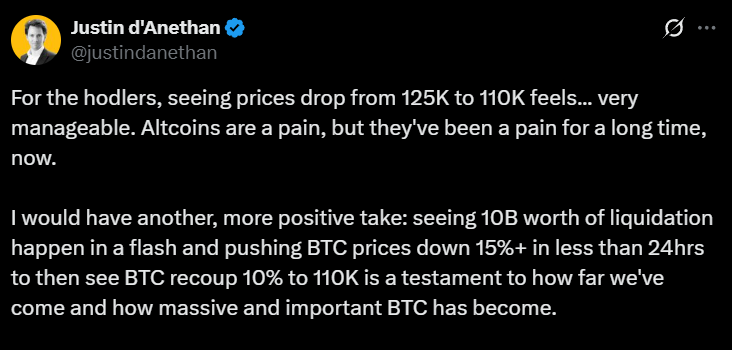
“I would have another, more positive take: seeing 10B worth of liquidation happen in a flash and pushing BTC prices down 15%+ in less than 24hrs to then see BTC recoup 10% to 110K is a testament to how far we've come and how massive and important BTC has become,” he posted on 𝕏.
Moreover, an important datapoint stands out. Exchange inflows to BTC have shrunk, signaling that fewer holders are moving coins to exchanges for sale. This signals that fewer investors are transferring their Bitcoin from personal wallets to exchanges, which is a common precursor to selling. In layman terms, coins are being held rather than prepared for trade.
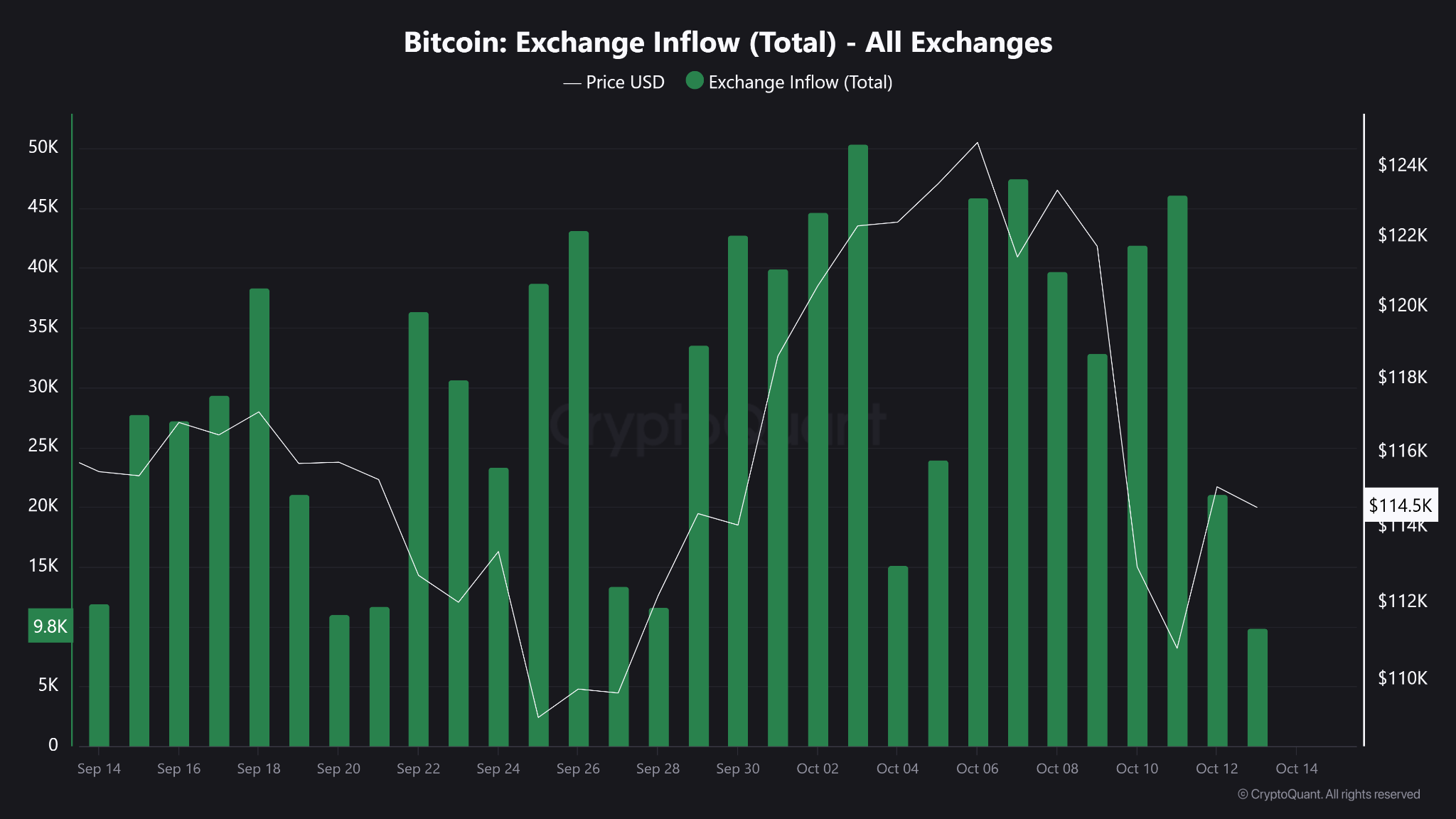
Bitcoin’s Backbone: Resilience Under Pressure
Bitcoin’s ability to rebound after extreme volatility has long been one of its defining traits. Friday’s drop admittedly sent shockwaves through the market, triggering billions in liquidations and exposing the fragility of leveraged trading.
Yet, as history has shown, such sharp pullbacks are far from new for the world’s largest cryptocurrency. In its short history, Bitcoin has endured dozens of drawdowns exceeding 10% in a single day (from the infamous “COVID crash” of 2020 to the FTX collapse in 2022) only to recover and set new highs months later.
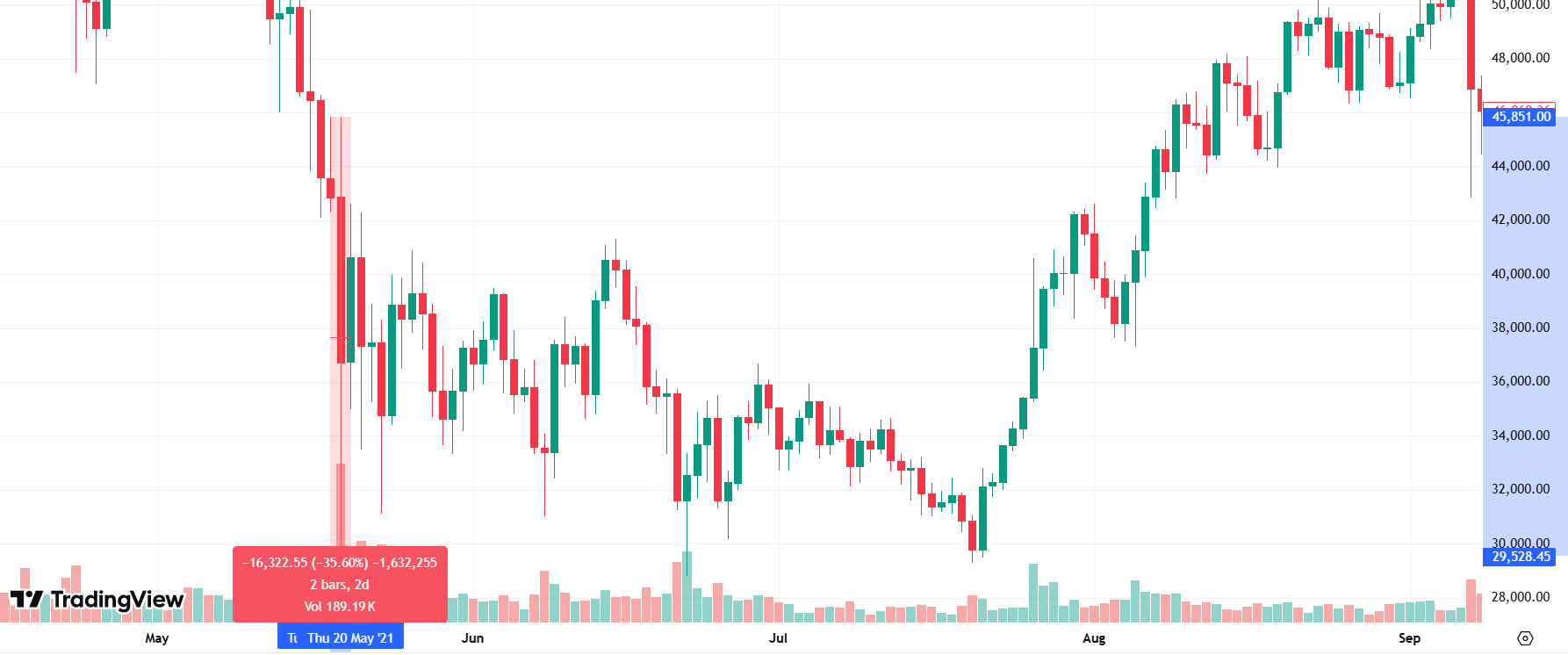
This latest event, while painful, highlights a maturing market structure. Since the approval of spot Bitcoin ETFs in early 2024, institutional involvement has deepened, creating greater liquidity buffers and stronger institutional confidence. Even as billions in leveraged positions were wiped out, Bitcoin has held firm around the $110,000 zone, a level that has since acted as psychological support.
What to Watch Next
The key question now is whether this rebound marks a short-term relief rally or the start of a renewed uptrend. Analysts are closely watching derivatives funding rates, on-chain flows, and ETF inflows for clues. A sustained increase in ETF demand could provide a steady bid under the market, offsetting the effects of future liquidation cascades. Meanwhile, Bitcoin’s ability to hold above $110,000 (an area of heavy trading volume) may serve as confirmation that investor confidence remains intact.
As the market digests the events of October 10, one lesson stands out. Bitcoin’s recovery isn’t just a matter of luck, it’s a reflection of underlying market structure that can absorb shocks. It is built on a growing base of long-term holders, institutional adoption, and a financial system increasingly intertwined with digital assets. Corrections, however dramatic, are not signs of weakness; they are reminders of a maturing market that is striding towards equilibrium.
Bottom Line
The crash on October 10 was brutal, there’s no denying that. It was one of the deepest and fastest in recent memory. But the recovery has been equally sharp. Rather than exposing faults, the rebound has underscored the market’s adaptability and Bitcoin’s central role.
The market consensus is seemingly leaning towards a reset; not a reversal. The shakeout purged excess leverage, and the comeback underlined demand. If Bitcoin can maintain that strength, and the broader market keeps its footing in the coming days, this could mark a turning point rather than a cave-in.

What's driving the crypto market this week? Get fast, clear updates on the top coins, market trends, and regulation news.
Welcome to Tap’s weekly crypto market recap.
Here are the biggest stories from last week (8 - 14 July).
💥 Bitcoin breaks new ATH
Bitcoin officially hit above $122,000 marking its first record since May and pushing total 2025 gains to around +20% YTD. The rally was driven by heavy inflows into U.S. spot ETFs, over $218m into BTC and $211m into ETH in a single day, while nearly all top 100 coins turned green.
📌 Trump Media files for “Crypto Blue‑Chip ETF”
Trump Media & Technology Group has submitted an S‑1 to the SEC for a new “Crypto Blue Chip ETF” focused primarily on BTC (70%), ETH (15%), SOL (8%), XRP (5%), and CRO (2%), marking its third crypto ETF push this year.
A major political/media player launching a multi-asset crypto fund signals growing mainstream and institutional acceptance, and sparks fresh conflict-of-interest questions. We’ll keep you updated.
🌍 Pakistan launches CBDC pilot & virtual‑asset regulation
The State Bank of Pakistan has initiated a pilot for a central bank digital currency and is finalising virtual-asset laws, with Binance CEO CZ advising government efforts. With inflation at just 3.2% and rising foreign reserves (~$14.5b), Pakistan is embracing fintech ahead of emerging-market peers like India.
🛫 Emirates Airline to accept crypto payments
Dubai’s Emirates signed a preliminary partnership with Crypto.com to enable crypto payments starting in 2026, deepening the Gulf’s commitment to crypto-friendly infrastructure.
*Not to take away from the adoption excitement, but you can book Emirates flights with your Tap card, using whichever crypto you like.
🏛️ U.S. declares next week “Crypto Week”
House Republicans have designated 14-18 July as “Crypto Week,” aiming for votes on GENIUS (stablecoin oversight), CLARITY (jurisdiction clarity), and Anti‑CBDC bills. The idea is that these bills could reshape how U.S. defines crypto regulation and limit federal CBDC initiatives under Trump-aligned priorities.
Stay tuned for next week’s instalment, delivered on Monday mornings.

Explore key catalysts driving the modern money revolution. Learn about digital currencies, fintech innovation, and the future of finance.
The financial world is undergoing a significant transformation, largely driven by Millennials and Gen Z. These digital-native generations are embracing cryptocurrencies at an unprecedented rate, challenging traditional financial systems and catalysing a shift toward new forms of digital finance, redefining how we perceive and interact with money.
This movement is not just a fleeting trend but a fundamental change that is redefining how we perceive and interact with money.
Digital Natives Leading the Way
Growing up in the digital age, Millennials (born 1981-1996) and Gen Z (born 1997-2012) are inherently comfortable with technology. This familiarity extends to their financial behaviours, with a noticeable inclination toward adopting innovative solutions like cryptocurrencies and blockchain technology.
According to the Grayscale Investments and Harris Poll Report which studied Americans, 44% agree that “crypto and blockchain technology are the future of finance.” Looking more closely at the demographics, Millenials and Gen Z’s expressed the highest levels of enthusiasm, underscoring the pivotal role younger generations play in driving cryptocurrency adoption.
Desire for Financial Empowerment and Inclusion
Economic challenges such as the 2008 financial crisis and the impacts of the COVID-19 pandemic have shaped these generations' perspectives on traditional finance. There's a growing scepticism toward conventional financial institutions and a desire for greater control over personal finances.
The Grayscale-Harris Poll found that 23% of those surveyed believe that cryptocurrencies are a long-term investment, up from 19% the previous year. The report also found that 41% of participants are currently paying more attention to Bitcoin and other crypto assets because of geopolitical tensions, inflation, and a weakening US dollar (up from 34%).
This sentiment fuels engagement with cryptocurrencies as viable investment assets and tools for financial empowerment.
Influence on Market Dynamics
The collective financial influence of Millennials and Gen Z is significant. Their active participation in cryptocurrency markets contributes to increased liquidity and shapes market trends. Social media platforms like Reddit, Twitter, and TikTok have become pivotal in disseminating information and investment strategies among these generations.
The rise of cryptocurrencies like Dogecoin and Shiba Inu demonstrates how younger investors leverage online communities to impact financial markets2. This phenomenon shows their ability to mobilise and drive market movements, challenging traditional investment paradigms.
Embracing Innovation and Technological Advancement
Cryptocurrencies represent more than just investment opportunities; they embody technological innovation that resonates with Millennials and Gen Z. Blockchain technology and digital assets are areas where these generations are not only users but also contributors.
A 2021 survey by Pew Research Center indicated that 31% of Americans aged 18-29 have invested in, traded, or used cryptocurrency, compared to just 8% of those aged 50-64. This significant disparity highlights the generational embrace of digital assets and the technologies underpinning them.
Impact on Traditional Financial Institutions
The shift toward cryptocurrencies is prompting traditional financial institutions to adapt. Banks, investment firms, and payment platforms are increasingly integrating crypto services to meet the evolving demands of younger clients.
Companies like PayPal and Square have expanded their cryptocurrency offerings, allowing users to buy, hold, and sell cryptocurrencies directly from their platforms. These developments signify the financial industry's recognition of the growing importance of cryptocurrencies.
Challenges and Considerations
While enthusiasm is high, challenges such as regulatory uncertainties, security concerns, and market volatility remain. However, Millennials and Gen Z appear willing to navigate these risks, drawn by the potential rewards and alignment with their values of innovation and financial autonomy.
In summary
Millennials and Gen Z are redefining the financial landscape, with their embrace of cryptocurrencies serving as a catalyst for broader change. This isn't just about alternative investments; it's a shift in how younger generations view financial systems and their place within them. Their drive for autonomy, transparency, and technological integration is pushing traditional institutions to innovate rapidly.
This generational influence extends beyond personal finance, potentially reshaping global economic structures. For industry players, from established banks to fintech startups, adapting to these changing preferences isn't just advantageous—it's essential for long-term viability.
As cryptocurrencies and blockchain technology mature, we're likely to see further transformations in how society interacts with money. Those who can navigate this evolving landscape, balancing innovation with stability, will be well-positioned for the future of finance. It's a complex shift, but one that offers exciting possibilities for a more inclusive and technologically advanced financial ecosystem. The financial world is changing, and it's the young guns who are calling the shots.

Unveiling the future of money: Explore the game-changing Central Bank Digital Currencies and their potential impact on finance.
Since the debut of Bitcoin in 2009, central banks have been living in fear of the disruptive technology that is cryptocurrency. Distributed ledger technology has revolutionized the digital world and has continued to challenge the corruption of central bank morals.
Financial institutions can’t beat or control cryptocurrency, so they are joining them in creating digital currencies. Governments have now been embracing digital currencies in the form of CBDCs, otherwise known as central bank digital currencies.
Central bank digital currencies are digital tokens, similar to cryptocurrency, issued by a central bank. They are pegged to the value of that country's fiat currency, acting as a digital currency version of the national currency. CBDCs are created and regulated by a country's central bank and monetary authorities.
A central bank digital currency is generally created for a sense of financial inclusion and to improve the application of monetary and fiscal policy. Central banks adopting currency in digital form presents great benefits for the federal reserve system as well as citizens, but there are some cons lurking behind the central bank digital currency facade.
Types of central bank digital currencies
While the concept of a central bank digital currency is quite easy to understand, there are layers to central bank money in its digital form. Before we take a deep dive into the possibilities presented by the central banks and their digital money, we will break down the different types of central bank digital currencies.
Wholesale CBDCs
Wholesale central bank digital currencies are targeted at financial institutions, whereby reserve balances are held within a central bank. This integration assists the financial system and institutions in improving payment systems and security payment efficiency.
This is much simpler than rolling out a central bank digital currency to the whole country but provides support for large businesses when they want to transfer money. These digital payments would also act as a digital ledger and aid in the avoidance of money laundering.
Retail CBDCs
A retail central bank digital currency refers to government-backed digital assets used between businesses and customers. This type of central bank digital currency is aimed at traditional currency, acting as a digital version of physical currency. These digital assets would allow retail payment systems, direct P2P CBDC transactions, as well as international settlements among businesses. It would be similar to having a bank account, where you could digitally transfer money through commercial banks, except the currency would be in the form of a digital yuan or euro, rather than the federal reserve of currency held by central banks.
Pros and cons of a central bank digital currency (CBDC)
Central banks are looking for ways to keep their money in the country, as opposed to it being spent on buying cryptocurrencies, thus losing it to a global market. As digital currencies become more popular, each central bank must decide whether they want to fight it or profit from the potential. Regardless of adoption, central banks creating their own digital currencies comes with benefits and disadvantages to users that you need to know.
Pros of central bank digital currency (CBDC)
- Cross border payments
- Track money laundering activity
- Secure international monetary fund
- Reduces risk of commercial bank collapse
- Cheaper
- More secure
- Promotes financial inclusion
Cons of central bank digital currency (CDBC)
- Central banks have complete control
- No anonymity of digital currency transfers
- Cybersecurity issues
- Price reliant on fiat currency equivalent
- Physical money may be eliminated
- Ban of distributed ledger technology and cryptocurrency
Central bank digital currency conclusion
Central bank money in an electronic form has been a big debate in the blockchain technology space, with so many countries considering the possibility. The European Central Bank, as well as other central banks, have been considering the possibility of central bank digital currencies as a means of improving the financial system. The Chinese government is in the midst of testing out their e-CNY, which some are calling the digital yuan. They have seen great success so far, but only after completely banning Bitcoin trading.
There is a lot of good that can come from CBDCs, but the benefits are mostly for the federal reserve system and central banks. Bank-account holders and citizens may have their privacy compromised and their investment options limited if the world adopts CBDCs.
It's important to remember that central bank digital currencies are not cryptocurrencies. They do not compete with cryptocurrencies and the benefits of blockchain technology. Their limited use cases can only be applied when reinforced by a financial system authority. Only time will tell if CBDCs will succeed, but right now you can appreciate the advantages brought to you by crypto.
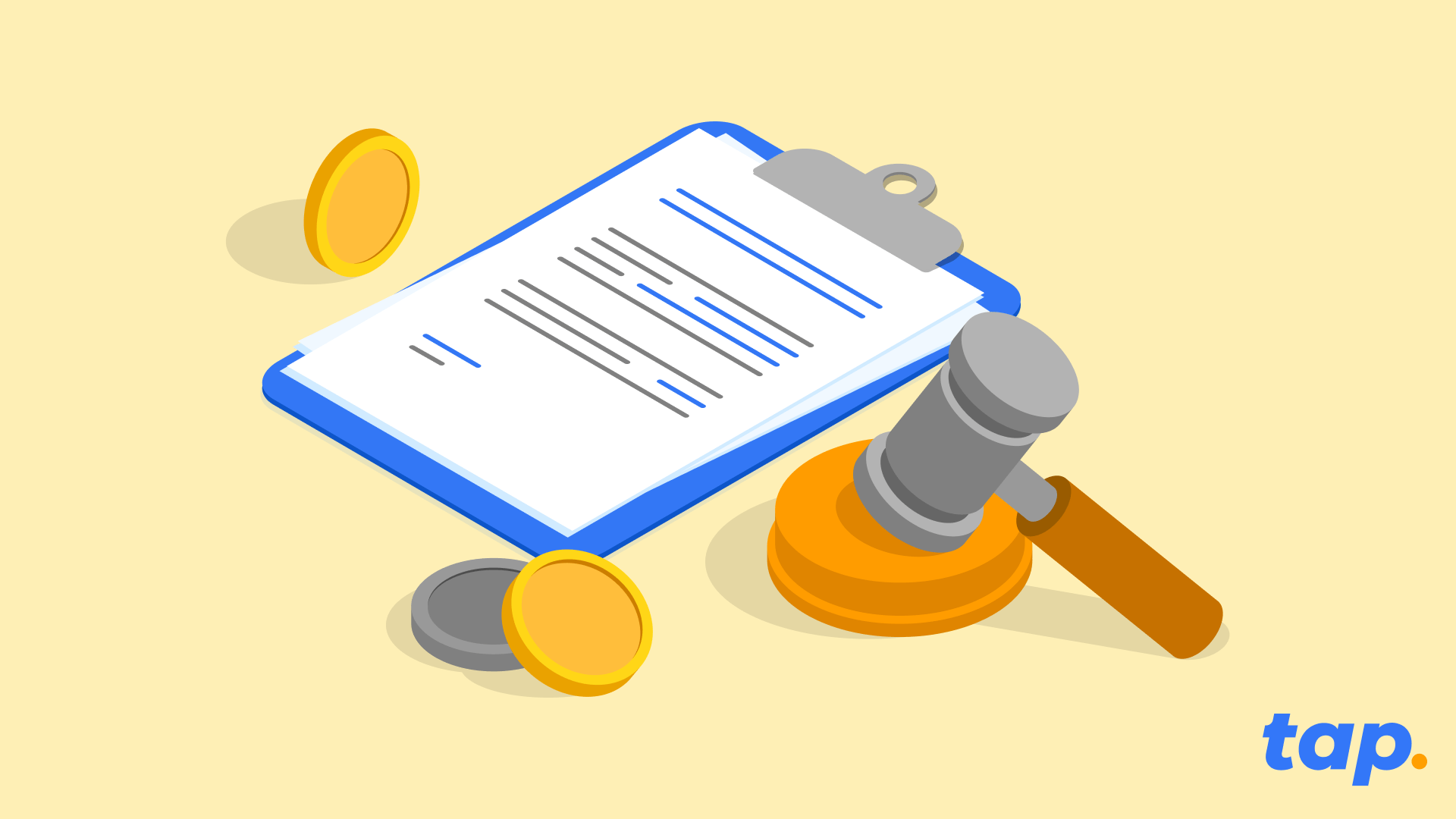
You might have heard of the "Travel Rule" before, but do you know what it actually mean? Let us dive into it for you.
What is the "Travel Rule"?
You might have heard of the "Travel Rule" before, but do you know what it actually mean? Well, let me break it down for you. The Travel Rule, also known as FATF Recommendation 16, is a set of measures aimed at combating money laundering and terrorism financing through financial transactions.
So, why is it called the Travel Rule? It's because the personal data of the transacting parties "travels" with the transfers, making it easier for authorities to monitor and regulate these transactions. See, now it all makes sense!
The Travel Rule applies to financial institutions engaged in virtual asset transfers and crypto companies, collectively referred to as virtual asset service providers (VASPs). These VASPs have to obtain and share "required and accurate originator information and required beneficiary information" with counterparty VASPs or financial institutions during or before the transaction.
To make things more practical, the FATF recommends that countries adopt a de minimis threshold of 1,000 USD/EUR for virtual asset transfers. This means that transactions below this threshold would have fewer requirements compared to those exceeding it.
For transfers of Virtual Assets falling below the de minimis threshold, Virtual Asset Service Providers (VASPs) are required to gather:
- The identities of the sender (originator) and receiver (beneficiary).
- Either the wallet address associated with each transaction involving Virtual Assets (VAs) or a unique reference number assigned to the transaction.
- Verification of this gathered data is not obligatory, unless any suspicious circumstances concerning money laundering or terrorism financing arise. In such instances, it becomes essential to verify customer information.
Conversely, for transfers surpassing the de minimis threshold, VASPs are obligated to collect more extensive particulars, encompassing:
- Full name of the sender (originator).
- The account number employed by the sender (originator) for processing the transaction, such as a wallet address.
- The physical (geographical) address of the sender (originator), national identity number, a customer identification number that uniquely distinguishes the sender to the ordering institution, or details like date and place of birth.
- Name of the receiver (beneficiary).
- Account number of the receiver (beneficiary) utilized for transaction processing, similar to a wallet address.
By following these guidelines, virtual asset service providers can contribute to a safer and more transparent virtual asset ecosystem while complying with international regulations on anti-money laundering and countering the financing of terrorism. It's all about ensuring the integrity of financial transactions and safeguarding against illicit activities.
Implementation of the Travel Rule in the United Kingdom
A notable shift is anticipated in the United Kingdom's oversight of the virtual asset sector, commencing September 1, 2023.
This seminal development comes in the form of the Travel Rule, which falls under Part 7A of the Money Laundering Regulations 2017. Designed to combat money laundering and terrorist financing within the virtual asset industry, this new regulation expands the information-sharing requirements for wire transfers to encompass virtual asset transfers.
The HM Treasury of the UK has meticulously customized the provisions of the revised Wire Transfer Regulations to cater to the unique demands of the virtual asset sector. This underscores the government's unwavering commitment to fostering a secure and transparent financial ecosystem. Concurrently, it signals their resolve to enable the virtual asset industry to flourish.
The Travel Rule itself originates from the updated version of the Financial Action Task Force's recommendation on information-sharing requirements for wire transfers. By extending these recommendations to cover virtual asset transfers, the UK aspires to significantly mitigate the risk of illicit activities within the sector.
Undoubtedly, the Travel Rule heralds a landmark stride forward in regulating the virtual asset industry in the UK. By extending the ambit of information-sharing requirements and fortifying oversight over virtual asset firms
Implementation of the Travel Rule in the European Union
Prepare yourself, as a new regulation called the Travel Rule is set to be introduced in the world of virtual assets within the European Union. Effective from December 30, 2024, this rule will take effect precisely 18 months after the initial enforcement of the Transfer of Funds Regulation.
Let's delve into the details of the Travel Rule. When it comes to information requirements, there will be no distinction made between cross-border transfers and transfers within the EU. The revised Transfer of Funds regulation recognizes all virtual asset transfers as cross-border, acknowledging the borderless nature and global reach of such transactions and services.
Now, let's discuss compliance obligations. To ensure adherence to these regulations, European Crypto Asset Service Providers (CASPs) must comply with certain measures. For transactions exceeding 1,000 EUR with self-hosted wallets, CASPs are obligated to collect crucial originator and beneficiary information. Additionally, CASPs are required to fulfill additional wallet verification obligations.
The implementation of these measures within the European Union aims to enhance transparency and mitigate potential risks associated with virtual asset transfers. For individuals involved in this domain, it is of utmost importance to stay informed and adhere to these new guidelines in order to ensure compliance.
What does the travel rules means to me as user?
As a user in the virtual asset industry, the implementation of the Travel Rule brings some significant changes that are designed to enhance the security and transparency of financial transactions. This means that when you engage in virtual asset transfers, certain personal information will now be shared between the involved parties. While this might sound intrusive at first, it plays a crucial role in combating fraud, money laundering, and terrorist financing.
The Travel Rule aims to create a safer environment for individuals like you by reducing the risks associated with illicit activities. This means that you can have greater confidence in the legitimacy of the virtual asset transactions you engage in. The regulation aims to weed out illicit activities and promote a level playing field for legitimate users. This fosters trust and confidence among users, attracting more participants and further driving the growth and development of the industry.
However, it's important to note that complying with this rule may require you to provide additional information to virtual asset service providers. Your privacy and the protection of your personal data remain paramount, and service providers are bound by strict regulations to ensure the security of your information.
In summary, the Travel Rule is a positive development for digital asset users like yourself, as it contributes to a more secure and trustworthy virtual asset industry.
Unlocking Compliance and Seamless Experiences: Tap's Proactive Approach to Upcoming Regulations
Tap is fully committed to upholding regulatory compliance, while also prioritizing a seamless and enjoyable customer experience. In order to achieve this delicate balance, Tap has proactively sought out partnerships with trusted solution providers and is actively engaged in industry working groups. By collaborating with experts in the field, Tap ensures it remains on the cutting edge of best practices and innovative solutions.
These efforts not only demonstrate Tap's dedication to compliance, but also contribute to creating a secure and transparent environment for its users. By staying ahead of the curve, Tap can foster trust and confidence in the cryptocurrency ecosystem, reassuring customers that their financial transactions are safe and protected.
But Tap's commitment to compliance doesn't mean sacrificing user experience. On the contrary, Tap understands the importance of providing a seamless journey for its customers. This means that while regulatory requirements may be changing, Tap is working diligently to ensure that users can continue to enjoy a smooth and hassle-free experience.
By combining a proactive approach to compliance with a determination to maintain user satisfaction, Tap is setting itself apart as a trusted leader in the financial technology industry. So rest assured, as Tap evolves in response to new regulations, your experience as a customer will remain top-notch and worry-free.
LATEST ARTICLE

Decentralized Finance, or DeFi, opens up a whole world of financial services for you, ranging from straightforward banking services to complex financial instruments similar to those used by hedge funds and investment bankers. But here’s the twist: it all operates with cryptocurrencies instead of traditional cash.
In DeFi, you can stake your cryptocurrency in what are called smart contracts, which essentially means locking up your funds to earn interest, known as Annual Percentage Yield (APY). As a token of appreciation for staking your funds and providing liquidity, DeFi projects grant you special project-specific tokens. These tokens aren’t just a thank-you note—they give you a say in the project’s future decisions and carry some speculative value too.
Before we get started, let us first address several terms you are likely to come across in this piece:
- Financial institutions are your traditional banks
- Centralized exchanges are crypto exchanges that are operated by a managing company
- Decentralized exchanges are crypto exchanges that are not managed by one company and typically work in a peer-to-peer manner.
- DeFi is decentralized finance and refers to the industry in which regular users can engage various financial services requiring only an internet connection.
How smart contracts work in the DeFi space
A smart contract is a digital agreement that automatically executes once the predetermined criteria have been met. These computer codes are facilitated by blockchain technology and rely on the blockchain that they are built on.
At the moment, your bank account from financial institutions might give you the right to a certain amount of monthly interest at a fixed rate. The deal is reached through a formal application procedure - which can take many days - that is handled by a mix of people and software and is acknowledged in writing. Once successful, the bank account is opened and you have access to the services.
A smart contract, on the other hand, uses a programming language (e.g. Solidity on Ethereum) to map out the mathematical aspects of an agreement - how much interest is due when and where it should be paid - while the underlying Ethereum blockchain executes the contract for a fee, making it transparent and unchangeable.
The ups and downs of the DeFi ecosystem
owever, it’s not all smooth sailing. DeFi can offer higher returns than traditional banks, which is quite appealing, but it also comes with higher risks. For instance, if something goes wrong with a smart contract, or you lose access to your private keys, there’s no safety net to catch you.
To dip your toes into DeFi waters, you’ll need a digital wallet like MetaMask and some funds from a cryptocurrency exchange. Once you’re set up, you can participate in various DeFi activities like lending or staking, each with its own set of fees depending on the network you’re using.
Additionally to the higher returns, DeFi tokens have also seen a rise in value, with some entering the top 20 and top 10 biggest cryptocurrencies based on market cap.
Furthermore, the value of DeFi tokens has surged, with some climbing into the top ranks of cryptocurrencies by market cap. This growth indicates a strong interest and a robust market presence, which can be exciting for anyone involved in the space.
However, it's not all smooth sailing. DeFi comes with its own risks that you should be aware of. For instance, executing smart contracts can get pricey, especially during times of network congestion. If you're looking to cut down on fees, you might want to explore alternatives to popular platforms like Ethereum, which can be more cost-effective.
Also, not all smart contracts are built the same. Some may have vulnerabilities that could put your funds at risk if not properly managed or if an error in the contract execution occurs. This highlights the importance of being careful with where and how you invest your digital assets.
Moreover, the decentralized nature of these platforms means that you’re in full control—which sounds great until you realize there is no safety net. If you lose access to your private key or make a transaction mistake, there's no customer service line to call for a do-over.
Ensure you vet various DeFi protocols before engaging
In general, more established Defi protocols with a higher total value of assets secured within them (also referred to as Total Value Locked, TVL) are safer. This is due to the fact that their code has been more thoroughly audited and "battle-tested".
Newer platforms will typically offer higher APYs in order to entice investors and build up liquidity. While this may sound lucrative, always ensure that you've done your research in order to understand exactly how the protocol operates and who is behind the project.
Here are a few things to look out for:
- Has the protocol's code been professionally audited?
- How long has the project been live?
- What is the platform's TLV? (The higher the better)
Finding your top Defi protocol
There are a number of "well-established" DeFi platforms that have proven reliable and trustworthy in recent years. While the risks are still prevalent, these are the most established options when looking to enter the DeFi space with the leading DeFi protocols.
How to use DeFi protocols (Get started in DeFi)
Jumping into the world of DeFi protocols can be quite an adventure. Here’s a simple guide on how to get started :
First, you'll need a digital wallet, and MetaMask is a popular choice. It's user-friendly and a common gateway for engaging with DeFi platforms.
Once you have your digital wallet, you'll need to move your cryptocurrencies into it. This is usually done through a transfer from a centralized exchange. For example, if you have a Tap wallet, you can transfer Ethereum (ETH) or other supported assets directly into your MetaMask wallet. Remember, DeFi protocols operate with cryptocurrencies, not traditional bank funds.
With your wallet set up and your funds in place, you can connect to any DeFi application that interests you. You can then engage with various features of the platform, such as depositing funds into a lending protocol. Keep in mind that actions like depositing, staking, unstaking, or withdrawing will typically involve network fees, which vary by blockchain.
That’s all there is to it! With these steps, you can start exploring the different functionalities and opportunities within DeFi at your own pace.
Understanding the risks associated with DeFi
While we've stressed that using tried and tested DeFi platforms provide a higher level of security, there are still risks associated with the DeFi space.
Below are some more steps you can do in order to secure your cryptocurrency assets and decrease the chance of losing your funds.
- Consider insurance, look into options for insuring your assets to help mitigate potential losses.
- Research the team behind the project, do your due diligence.
- Familiarize yourself with the platform's operations and features. For instance, if a platform advertises a certain return rate, such as 10% APY, delve into how they achieve those figures.
- Don’t commit more than you can afford to lose
Decentralized finance is one of the most innovative and promising areas in cryptocurrency. It is also a harsh environment, however, that demands some expertise before stepping in.
Before you place any funds into Defi protocols and become one of the many liquidity providers, ensure that you've fully vetted the project and considered the pros and cons of what it has to offer. Also ensure that you understand how the platform operates.
The DeFi space can be both lucrative and devastating, it is complex and requires a good amount of know-how. If you wish to get involved, take the time to really understand both the opportunities and the challenges it presents first. This way, you can engage with DeFi more cautiously and equipped with the necessary knowledge. And remember with Defi everything is at your own risk.

The Lightning Network is a second layer solution that enables Bitcoin users to make fast and cheap transactions without compromising on security. The layer two technology allows users to enjoy the benefits of both the Bitcoin and Lightning Network layers simultaneously. Learn more about the Lightning Network solution below.
The Bitcoin trilemma
In order to compete with other payment channels like Visa, the Bitcoin network must be able to process transactions much faster and at a fraction of the cost. However, this scaling cannot come at the expense of decentralization or security.
The "Bitcoin trilemma" is a term used to outline the conflict between these three principles, scaling, security, and decentralization.
The aim of Bitcoin Cash, Bitcoin SV, and other forks was to increase the block size in order to make Bitcoin transactions faster and more affordable on-chain.
However, these attempts failed to produce an effective method to transact quickly and inexpensively on-chain while still maintaining Satoshi's design. Hence, the Bitcoin Lightning Network.
The lightning network payment channels solution
Is it possible for the Bitcoin network to have it both ways, to keep its original architecture while also functioning as a fast micropayments network? The answer is yes, and thanks to the advent of Lightning Network transactions, Bitcoin can be used for everyday transactions like paying for a cup of coffee.
The Lightning Network is a type of layer two solution that is compatible with the Bitcoin service. This off-chain solution was first conceptualized in 2015 by Joseph Poon and Thaddeus Dryja.
The Lightning Network works by removing the burden of micropayments from the Bitcoin blockchain and instead utilizes multiple payment channels, which are controlled via multi-signature (multi-sig) Lightning Network wallets.
Why the lightning network?
How quickly can the Bitcoin network process transactions? Bitcoin is presently capable of processing between 2 and 7 transactions per second.
Visa, the current payment channel that drives your debit and credit card transactions, handles 150 million transactions each day, that's 24,000 transactions per second.
In order to make Bitcoin a competitive service to Visa, the Lightning Network needs to be implemented. This channel ensures that micropayments are instantly and cost-effectively executed, and is able to process thousands to hundreds of thousands of transactions instantly.
The core concepts of how the Lightning Network works.
So how does the Lightning Network work? This layer 2 solution works on top of the Bitcoin blockchain, allowing thousands of micropayments to be executed at one time. This lowers the costs and increases the transaction speed of the initial transaction. There are three core components of the Lightning Network: the nodes, channels, and invoices.
Lightning Network Nodes
This software connects with other nodes in order to form a network that connects to the Lightning Network to facilitate the sending and receiving of Bitcoin.
Lightning Network Channel
Users of the Lightning Network establish payment channels with one another so that they may conduct transactions off-chain, which can then be settled (closed) on the mainchain (on-chain).
Invoices
Invoices are QR codes that represent requests for Lightning Network payments on the Lightning Network. Invoices include all of the data necessary to complete a payment on the network, such as the payment amount, which blockchain the invoice is associated with, expiration date, payee pubkey, routing hints, and other information.
How to use the lightning network
In order to make use of the Bitcoin Lightning Network, you will need to open a compatible Lightning Network wallet. Once you have downloaded and signed up for the wallet, you will need to send funds. Simply locate the wallet address of the Lightning Network-enabled wallet and send the funds via your normal payment channel. Once the funds appear in your wallet, you can then send transactions via the Lightning Network to other enabled wallets.

Building wealth doesn't have to wait until you're settled down and "old". In fact, the sooner you start the better. Whether you want to buy a house one day, or start saving for retirement, starting to generate wealth earlier on will help you achieve these goals sooner.
Your 20’s & 30’s pose an excellent opportunity to build wealth as these years allow you to learn from your mistakes and take risks with a minimal downside (far fewer than if you started this process when you've got a family to support or an upcoming retirement).
There are two important notions to remember: this is not a get-rich-quick scheme, nor does it need to be complicated. Building wealth is more about setting yourself up on the fast but responsible track to wealth in later years.
8 Tips on how to build wealth
Below are 8 tips on how to stay on the straight and narrow when it comes to generating wealth.
- Create a living expenses budget and stick to it
It might not sound glamorous, but budgeting and saving money is not as bad as you think. Creating a budget for your living expenses (and sticking to it) is one of the surest ways to grow your money in the long term. Explore options like the 50/30/20 rule or 70/20/20 rule to establish what to spend on needs, wants, and savings each month and provide frameworks that allow you to save more money.
Living on a budget doesn't mean skimping on luxuries, it simply means managing spending money on luxuries and not overspending. It also trains us not to live paycheck to paycheck and instead determine exactly what we are spending our money on and ultimately save more money for the things we want to do in life (like buy a house or build a healthy retirement fund).
Financial independence takes work but is not entirely out of reach for anyone. One needs to start building a financial plan today in order to accumulate wealth further down the line.
2. Start eradicating your debt (from credit card debt to student loan debt)
Prioritise paying off your debt and living within your means in order to build your personal capital. Of course, sometimes debt is unavoidable, but bouncing back is imperative to building wealth down the line. Consider saving up to pay off your debt before using those savings for investments.
The 20/10 rule stipulates that you use a maximum of 20% of your annual net income on consumer debt, while each month you use no more than 10% of your net monthly income to pay off this debt. Ideally, stay away from consumer debt entirely and prioritize paying off anything you owe so that you can have more money in the long run.
3. Explore the working world
Your 20s are a great time to try new things in the job world. Explore new opportunities and build your experiences to grow your earning potential down the line. Consider each new job experience an opportunity to grow your skill set and increase your earning potential as you ascend the corporate jungle gym.
While a job might not pay more money, the experience it gives you can leverage your next job and result in greater financial success. It also might help you find money-minded friends, a great benefit to have when building wealth and personal capital.
4. Increase your income streams and make more money
While you're gaining experience in the working world consider building multiple income streams through side hustles, your own business or freelance gigs. Not only will this too contribute to a wider skill set, but will also create additional income streams which can be used for investments or holidays. You can build wealth while enjoying life, and additional income streams are the surefire way to do this and achieve financial freedom.
5. Educate yourself on finances
You're more likely to grow financially if you understand finances. Never underestimate the power of being financially literate and having the right money mindset. Use your twenties to read books, articles, and blogs to gain both knowledge and street-smartness to help you navigate your journey to financial freedom.
6. Investing
First, and as a continuation of the point above, do your own research before investing in any asset class. Investing from an early age can have ample benefits (read up on compound interest for one), but doing so without understanding how investments work can have dire consequences. Educate yourself or consult a professional, and start small. You don't need a huge amount of capital to get started.
7. Build an emergency fund
An emergency fund is 3-6 months' worth of living expenses and is a major contributor to financial wellness and laying the right financial foundation for later in life. Emergencies in life are inevitable, whether it be a medical emergency, a family crisis, or a car or house emergency, and an emergency fund is a surefire way of avoiding financial ruin as a result.
Learn more about building an emergency fund in our 7 simple steps to start (and build) your emergency fund article.
8. Get started with your retirement fund
It might not sound sexy, but starting to save for your retirement in your 20s is ideal. Starting to save for retirement when it's right around the corner isn't advised, so why not start now so that it can grow into something substantial by that time? Imagine what two to three decades of retirement savings might look like, compared to a few years.
As always, do your research and start small. You might even find that you can retire much earlier than expected. This is the number one mistake that young people make today.
In Conclusion
There's no time like the present to start considering your financial situation and what you can do now to make it prosper in the years to come. Avoid get-rich-quick schemes and use the time to take educated risks, the earlier you start working on your growing wealth journey, the better.
Even if you're not earning a lot, be diligent and consistent and you will see results. Start building these habits now and you will reap the rewards along the way.
Disclaimer: This article is intended for communication purposes only, you should not consider any such information, opinions, or other material as financial advice.
-your-emergency-fund.png)
We've all been caught off guard with an emergency payment - from having to replace an appliance to an unexpected medical bill. These things happen and they're out of our control, so it's best to be prepared. Emergency funds are the best way to protect yourself, and a great way to start building your savings.
These unforeseen expenses shouldn't cripple your savings. With an emergency savings fund, you can recover more quickly and get back on track to achieving your financial goals with little to no stress.
What is an emergency fund?
An emergency fund is easily accessible money stored in a bank account set aside specifically for unexpected expenses or financial emergencies, anything from medical expenses to a loss of income. Emergency savings are typically used for unplanned expenses that fall outside of your normal monthly spending, with the funds stored in a savings account.
These funds allow you to weather the storm and avoid the need (and costs) of taking out a high-interest loan or credit card debt. Keeping the funds in a savings account removes the temptation to spend it, as would be the case if you stored the funds in a checking account.
Why emergency savings are important
Emergency or unexpected expenses without the proper precautions can quickly turn into debt or take a toll on your savings goals. And if hit with two or more in a row, this might cause long-term consequences that cause havoc on your finances.
Rather rest assured knowing that you have an emergency fund in place should something unexpected happen than fall back on costly loans and credit cards, or even other savings accounts like your retirement savings.
Emergency funds play an essential role in any reliable financial plan, providing peace of mind and a buffer for your other savings accounts. These funds can be used during periods of unemployment, the sudden death of a family member, illness and disability, or emergency home and auto repairs. Never underestimate the importance of an emergency fund and its impact on your financial well-being should something go wrong.
Start your emergency fund with these 7 simple steps
1. Review your monthly budget and see where you can save
It's critical to understand where your money is going so you can find ways to save it. Budgeting allows you to maximize your income and discover methods to decrease or control your spending.
To do this you can sit down with a financial advisor, or take matters into your own hand with your checking account statements, a pen and paper or a budgeting app. Be sure to review both your checking and savings accounts to get a clear picture. This is the first step in improving your financial health, and to start building your emergency fund.
2. Establish a goal amount for your emergency fund
A budget is a plan for spending that helps you figure out how much money you'll need each month to meet your essential expenses. A general rule of thumb when looking to build an emergency fund goal is to aim for six months' worth of income, enough to cover monthly expenses for housing, food, and transportation.
Don't be discouraged by how long this will take, rather establish a goal to work towards and move forward in that direction. Ideally, you want to be able to cover your living expenses for six months.
3. Create a direct deposit to your savings account
Avoid temptation by setting up a direct deposit from your current bank account (or wherever you receive your income) to your savings account. Better yet, you can create a split direct debit which allows you to automatically allocate funds to various accounts, including retirement funds etc.
If you're new to saving, experts recommend starting with an emergency fund, and once you've established this, move on to other savings accounts. If you already have a retirement fund or money market account set up, continue with this while building your emergency fund.
4. Little by little increase your savings
Increase the amount you're putting into your emergency fund by 1 percent or a certain amount over time until you've reached your savings goal. Increasing amounts gradually might help to make the smaller deposit into your checking account seem less noticeable and steadily build financial security.
5. Direct any unexpected income straight to your savings accounts
Commit to redirecting any unexpected income to your emergency fund, at least until you have reached your saving goal. This might be money from a bonus, inheritance, a tax refund, lottery winnings etc.
6. And once you've reached your goal? Save some more
Being unemployed for more than a year or being hospitalized for several months are both situations that require more than a six-month cushion. Should you find yourself here you’ll be glad you have more money saved in your emergency fund.
7. Find a bank account with perks that can kickstart your savings
When opening new checking or savings accounts, shop around by observing bank or credit union offers. Some banks offer cash incentives to new customers. Use this to kickstart your emergency fund, or to add a little extra to an already established one.
In conclusion
An emergency fund provides a cushion for unplanned events and can help you avoid taking on credit card debt or taking out a personal loan. By putting your emergency money in a high-yield savings account as opposed to checking and savings accounts, you can earn interest while you save money and build your nest egg.
Having an emergency fund saved in a separate account prevents you from spending the money and ensures that it is accessible in the case of an emergency. Emergencies can occur whether or not you are prepared; as a result, being prepared is the best way to deal with a potentially difficult scenario.

Knapphet är ett grundläggande begrepp som beskriver klyftan mellan våra oändliga behov och de begränsade resurser som finns tillgängliga i världen. Det handlar inte bara om varor och tjänster i vardagen — knapphet spelar också en avgörande roll inom investeringar och finans.
Att förstå knapphet hjälper oss att se hur resurser används, hur marknader fungerar och varför priser sätts som de gör. Oavsett om du tänker på globala resursutmaningar eller möjliga investeringsmöjligheter, är det viktigt att förstå hur knapphet påverkar beslutsfattandet.
Vad betyder knapphet?
Inom ekonomin syftar knapphet på det faktum att det finns en begränsad mängd råvaror, arbetskraft, mark och kapital, samtidigt som behoven och önskemålen hos individer, företag och hela samhällen är i princip oändliga.
Ur ett investeringsperspektiv kan knapphet visa sig i form av ett begränsat utbud av högkvalitativa aktier. Medan allt fler vill hitta lönsamma investeringar, finns det bara ett visst antal välpresterande bolag att satsa på.
Denna begränsning driver ofta upp priserna på attraktiva tillgångar, eftersom fler vill äga en bit av något som det finns lite av. Det innebär att investerare måste prioritera klokt – och väga potentiell avkastning mot högre kostnader.
Vad påverkar knapphet?
Ekonomer använder begreppet knapphet för att förklara varför vissa resurser som tidigare var lättillgängliga plötsligt blir svåra att få tag i. Det finns tre huvudorsaker till knapphet:
Efterfrågedriven knapphet
Detta sker när efterfrågan överstiger tillgången. Exempel: En ny populär spelkonsol släpps och säljer slut direkt eftersom så många vill ha den.
Utbudsdriven knapphet
Här är det yttre faktorer som påverkar tillgången, till exempel tillverkningsproblem eller naturkatastrofer. Ett exempel är chipbrist som påverkar hela elektronikindustrin.
Strukturell eller relativ knapphet
Denna typ av knapphet uppstår när vissa grupper har bättre tillgång till resurser än andra, ofta på grund av politiska eller ekonomiska ojämlikheter – inte på grund av resursens faktiska tillgång.
Knapphet i olika branscher
Knapphet påverkar olika branscher på olika sätt. Inom jordbruket kan torka eller dåliga skördar minska tillgången på livsmedel, vilket driver upp priserna och förändrar konsumentbeteenden.
Inom teknik kan brist på komponenter som mikrochip fördröja produktion, göra produkter dyrare och begränsa tillgången. I sjukvården kan brist på läkemedel eller utrustning höja kostnader och försvåra tillgången till vård.
Inom finans påverkar knapphet också kapitalfördelning. När det finns begränsat med kapital eller attraktiva investeringar måste investerare fatta strategiska beslut – vilket i sin tur driver upp priserna på eftertraktade tillgångar.
Hur påverkar knapphet oss?
I dagens samhälle påverkar knapphet alla – privatpersoner, företag och regeringar.
För privatpersoner innebär det svåra val kring vad pengarna ska användas till. Företag kan ha svårt att få tag på råvaror, vilket påverkar produktionen och priserna. Regeringar måste ta hänsyn till knapphet när de utformar politik, budgetar och samhällsprojekt.
Knapphet driver ekonomisk politik och påverkar hur resurser fördelas. Den formar också marknadsdynamiken – när tillgång och efterfrågan förändras påverkar det priser, utbud och efterfrågan i hela ekonomin.
Knapphet inom ekonomi
Ur ett investeringsperspektiv innebär knapphet att det finns ett begränsat utbud av en viss tillgång, samtidigt som efterfrågan är hög – vilket i sin tur kan driva upp priset.
Det kan handla om allt från naturresurser till populära kryptotillgångar. När något blir svårt att få tag på ökar ofta dess värde. Ett tydligt exempel är Bitcoin, som har ett maxutbud på 21 miljoner coins. När fler efterfrågar något som är begränsat i utbud, tenderar priset att öka.
Strategier för att hantera knapphet på marknaden
Oavsett om du investerar eller handlar aktivt, här är sex strategier att ha i åtanke för att navigera marknader där knapphet spelar roll:
- Diversifiera dina investeringar – Sprid dina investeringar för att minska risken om en bransch påverkas av brist.
- Välj stabila sektorer – Satsa på områden där tillgången på resurser är god och förutsägbar.
- Utforska nya marknader och teknologier – Håll ögonen öppna för innovation och framväxande sektorer.
- Tänk långsiktigt – Tillgångar som fastigheter eller råvaror kan behålla sitt värde över tid.
- Håll dig informerad – Följ marknadstrender, utbudsproblem och förändringar i efterfrågan.
- Fundera på hållbarhet – Investera i teknologier och lösningar som hanterar resurser på ett effektivt sätt och kan bidra till framtida stabilitet.
Observera: detta är endast generella förslag och inte finansiell rådgivning. Gör alltid noggrann research innan du fattar investeringsbeslut.
Slutsats
Knapphet är ett centralt begrepp inom ekonomi som visar klyftan mellan våra oändliga behov och världens begränsade resurser.
Det påverkar alla – från privatpersoner till företag och hela regeringar. Genom att förstå hur knapphet fungerar kan vi fatta bättre beslut, investera klokare, och använda våra resurser mer effektivt.
Knapphet formar vår ekonomi, våra marknader och våra möjligheter – att förstå det är nyckeln till att navigera dagens komplexa värld.

The financial industry has seen significant growth within its digital sector due to the adaptation required during Covid-19. With the increased interest in digital payments has come the rise of virtual cards.
Shopping online and online purchases continue to break barriers that traditional financial institutions never predicted. While these institutions do allow users to do online shopping, there are still a lot of limitations and risks to be wary of.
Every time you shop online, you risk your account number and details being stolen and used against you. Credit card companies have had to evolve, and one way they have done that is through the introduction of an actual account-linked virtual card.
How do virtual credit cards and debit cards work?
Virtual cards are stored on your mobile device and can be used to make contactless payments in store or online. A virtual card has its own unique card number, CVC, and expiration date. These virtual cards are simply a copy of your physical card, linked to your bank account, and stored on your application or phone. Think of it as an online account and card.
Virtual cards are very similar to an actual credit or debit card, with the main difference being that they only exist digitally, and can not be used to withdraw physical cash. Virtual credit cards provide the same features and mechanics as traditional credit and debit cards.
A virtual credit card still has an expiry date and 16-digit account number, and CVV codes. They are connected to payment networks like Visa and Mastercard and are generally accepted by merchants who use physical card machines, similar to Apple and Google Pay.
Your virtual card information and virtual credit card number are stored digitally, eliminating the risk of someone stealing your card and simply entering your details when shopping online.
Virtual credit cards act as digital wallets, providing more advanced security and ease of online access. Virtual cards are created for one-time use or act as a temporary account number, but what are the benefits of a limited-use virtual card number? Let’s get into it.
Benefits of a virtual credit card
The first and foremost virtual credit card feature benefit that you can expect is an enhanced layer of security. To combat fraudulent activity, a data breach, and account information being stolen, virtual cards have randomly generated and disposable card numbers. This makes virtual cards one of the safest payment methods, eliminating physical and confirmed details, meaning your temporary information can not be stolen or lost. If your info is compromised, you can cancel it without having to create a new bank account or waiting for a new card in the mail.
Control and customization is an additional layer of benefits users can expect from using virtual credit cards. Users can customize how many virtual account numbers they want, set spending limits, choose their preferred currencies, and more. Similar to a normal debit card account, you can also create recurring payments with merchant details, as tailored to the amount, time, and so on.
Some virtual credit cards provide users with point-earning rewards or store credit when used. Credit card companies can also easily access your information to improve your credit score based on your recurring payments set up.
Creating multiple virtual debit cards allows you to distribute, allocate, and track funds with ease. This means at the end of the day, you have more visibility of your funds going in and out and can create a dedicated virtual debit card for a specific area of your financial responsibilities.
Getting your virtual card number
Whether you are trying to manage your funds with your debit or credit cards accounts, a virtual card can make matters easier. All you need is a debit or credit card account, such as the one offered by Tap and you can create your unique virtual card at the click of a button. With some traditional banks you can even create multiple cards if you want, each with its own unique account number and expiration date.
These digital wallets and accounts provide ease when you want to shop online, avoid physical wallet and card theft, as well as easier fund management. A virtual debit card is a big part of the future, as we move into the digital era.
Experience a whole new world of digital payments and money management from the safety of your mobile device. You should be able to use your virtual card at any merchant that accepts debit and credit card payments, or contactless transactions, such as Apple Pay or Google Pay. Create your virtual account number today and enjoy purchases online and in-store. The future of payments is here.
Kickstart your financial journey
Ready to take the first step? Join forward-thinking traders and savvy money users. Unlock new possibilities and start your path to success today.
Get started